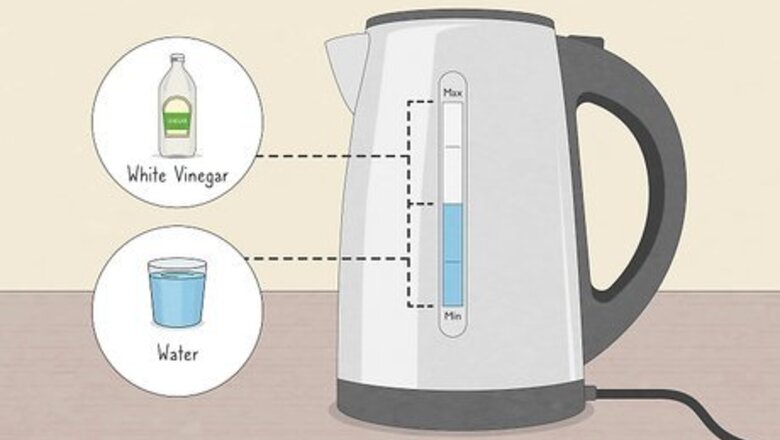
views
- Descale your kettle once per month. Fill it with equal parts white vinegar and water, bring it to a boil, and then let the solution sit for 20 minutes before rinsing it out.
- Or, fill your kettle with water and either 2 tbsp (30 ml) of lemon juice or 1 tbsp (17 g) of baking soda. Boil the solution, let it sit for 1 hour, and rinse it out.
- Wipe the outside of your kettle with a damp, microfiber cloth daily to keep it in tip-top shape.
Cleaning with Vinegar
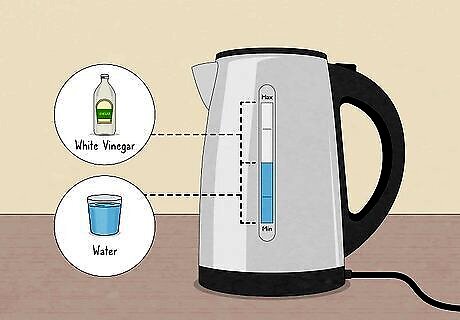
Fill your kettle with equal parts white vinegar and water. Vinegar contains acetic acid, which gently breaks down limescale and other mineral deposits in your electric kettle. Just fill your kettle to the max line with equal parts white distilled vinegar and water.

Boil the vinegar and water solution in the kettle. To soften and remove the limescale buildup inside your kettle, turn it on with the vinegar and water solution inside. Then, wait for the mixture to come to a boil.
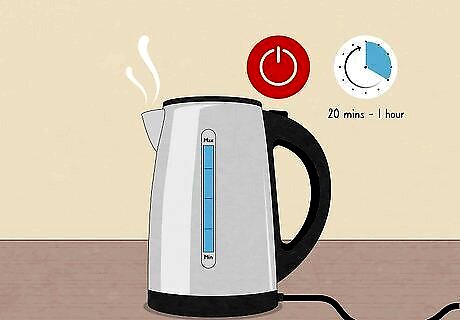
Let the vinegar solution sit for 20 minutes to 1 hour. Turn off the kettle and unplug it when the vinegar solution is boiling. Then, simply let the solution sit inside the kettle for about 20 minutes to 1 hour to help soften the mineral deposits further. If the scaling inside your kettle is severe, let the solution sit overnight.
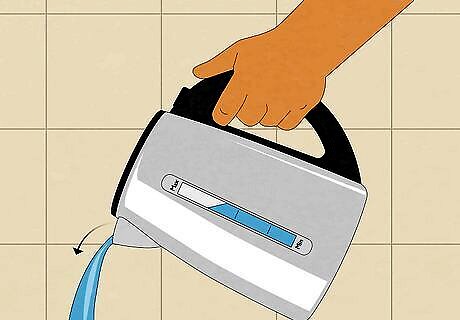
Pour out the vinegar solution and rinse the inside with water. Carefully drain the vinegar and water mixture out of the kettle, as it might be hot. Then, fill your kettle with water and pour it out 1 to 2 times to remove the vinegar smell and any leftover bits of limescale. If you still smell vinegar, fill your kettle with water, boil it, and then pour it out. Just keep boiling and pouring out the water until any lingering vinegar is gone. If your kettle has a filter, clean it by removing it from your kettle and running it under water.
Scrub the inside with a soft sponge if there’s any remaining scaling. Inspect your kettle to see if any stubborn mineral deposits are still inside. If you see any, dampen a soft, non-metallic sponge or microfiber cloth and scrub the inside of the kettle. Then, simply rinse your kettle out with water 1 to 2 times. Do not use abrasive scouring sponges inside your kettle as they can damage the lining.
Cleaning with Lemon Juice or Citric Acid

Add lemon juice or citric acid to your kettle that's half full with water. Lemon juice and citric acid are very acidic and easily remove limescale inside your electric kettle. Just fill your kettle halfway with water and then pour in 2 tbsp (30 ml) of lemon juice or 2 tbsp (22 g) of citric acid. Feel free to use lime juice in place of lemon juice or citric acid.
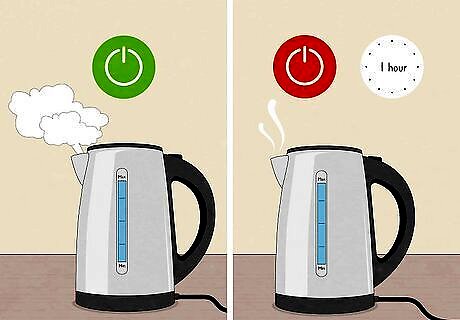
Boil the water and let the solution sit for about 1 hour. Turn on your kettle to bring the citrus water to a boil. Then, turn off your kettle and let the water sit inside for 1 hour. This helps soften the limescale so it pours right out of your machine. Let the lemon juice or citric acid solution sit in the kettle overnight if you’re dealing with stubborn mineral deposits.

Pour out the water and rinse your kettle 1 to 2 times. Carefully drain your kettle to remove the citrus water and mineral deposits. Then, flush the inside of your kettle several times with water to remove any lingering citrus smells. If you see any limescale after pouring out the citrus solution, scrub the inside of your kettle with a soft sponge or cloth.
Cleaning with Baking Soda
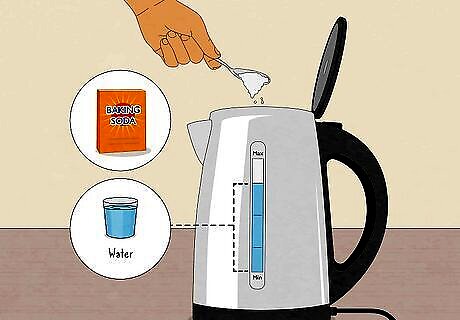
Fill your kettle ¾ full with water and add 1 tbsp (17 g) of baking soda. Baking soda is an effective kettle descaler that gently scrubs off mineral deposits. Simply fill your kettle about ¾ full with water and then dump in 1 tbsp (17 g) of baking soda.

Bring the baking soda solution to a boil and let it sit for 1 hour. Plug in your electric kettle and wait for the water and baking soda mixture to boil. Then, turn it off and let the solution sit for 1 hour, giving it time to lift off and dissolve the limescale. Keep the solution inside the kettle overnight if the limescale is severe.
Drain the kettle and rinse it out with water 1 to 2 times. Pour out the baking soda solution slowly, as the water is likely still hot. Then, fill the kettle with water and pour it out 1 to 2 times to get rid of any leftover baking soda and mineral deposits. If there are still some visible spots of limescale inside your kettle, wipe them off with a damp cloth or soft sponge.
Cleaning with Soda
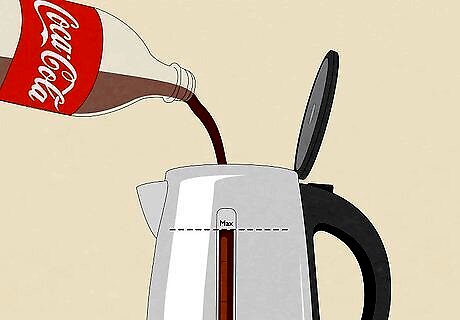
Fill your kettle to the max line with soda. Fizzy sodas like Coca-Cola contain acids that can break down stubborn mineral deposits. To easily clean out your kettle, just fill it to the max line with the soda of your choice.
Boil the soda and let it sit for 30 minutes. Power on your electric kettle and wait for the soda to start boiling. Then, turn off your machine and leave the soda inside for 30 minutes. While you’re waiting, the acids are breaking down the tough limescale buildup.

Pour out the soda and rinse the inside of your kettle with water. Drain out the soda inside your kettle, pouring carefully to prevent any hot liquid from splashing on you. Then, fill the kettle with water and pour it out, repeating this 1 to 2 times until the soda smell is gone from your machine. Scrub any remaining limescale off of your kettle using a damp soft sponge or cloth. If you’re still seeing limescale, fill your kettle with soda again, bring it to a boil, and let it sit for 30 minutes. Then, pour it out and rinse the kettle.
Cleaning with Kettle Descaler

Fill your kettle ⅔ full with water and a kettle descaler. If you don’t want to make your own descaling solution, most electric kettle brands make cleaning solutions to remove limescale and mineral deposits in your machine. Just fill your kettle about ⅔ full with water and add in the descaling solution. Some kettles have slightly different directions, so always follow your machine's instructions when descaling it with a commercial descaler solution.
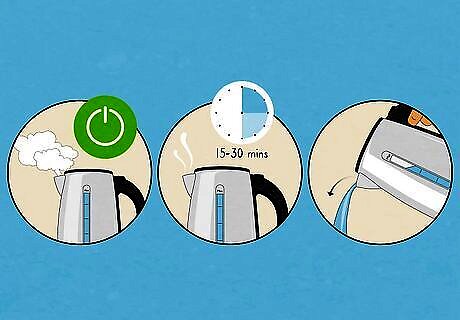
Boil the mixture, let it sit for 15-30 minutes, and then pour it out. Turn on your electric kettle and bring the water and descaler to a boil. Then, turn off the kettle and let the solution sit for 15 to 30 minutes, or according to your machine and descaler’s instructions. Pour out the solution and then rinse out your kettle with water.
Cleaning the Outside of Your Kettle

Wipe the exterior of your kettle with a damp cloth daily. To keep the outside of your electric kettle sparkling, dampen a soft, microfiber cloth with water. Wipe away any food debris or dust with the cloth, avoiding the bottom of the kettle so you don’t damage the heating element or electronics. Then, use a dry cloth to wipe away any moisture. Do not submerge your kettle in water or run the exterior under water. Water can damage the electronics and heating elements. Do not use scouring pads or other abrasive sponges to clean the outside of your electric kettle, as they might scratch the exterior.
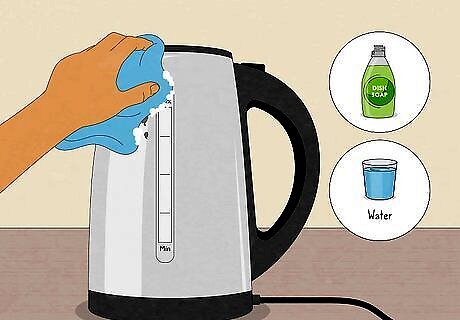
Clean off grease splatters with dish soap and water. If you keep your electric kettle by your stove, it might get sprayed with oil, butter, and other greasy foods. To clean off greasy spots, dampen a soft cloth in a mixture of dish soap and water and wipe it over your kettle. Then, wet a clean cloth with just water and wipe down your kettle to remove any soapy residue. Keep the lid on your kettle to prevent dish soap from getting in your machine, as soap isn’t recommended for use inside. If you accidentally get dish soap inside your kettle, rinse out the inside with water. Use a dry, microfiber cloth to wipe away any water on the outside of your kettle.
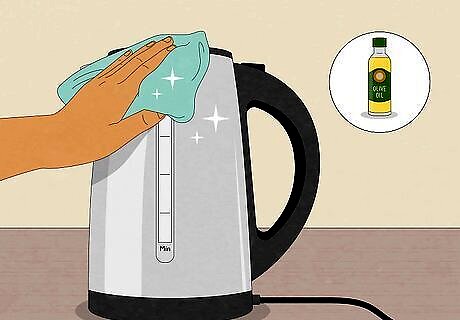
Polish stainless steel electric kettles with olive oil. Leave the outside of your stainless steel kettle shining by pouring 1 tsp (5 ml) of olive oil onto a clean, microfiber cloth. Then, gently buff the oil into the kettle by wiping the cloth in the direction of the stainless steel’s grain.




















Comments
0 comment